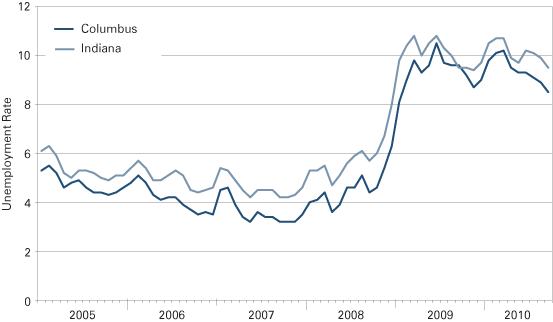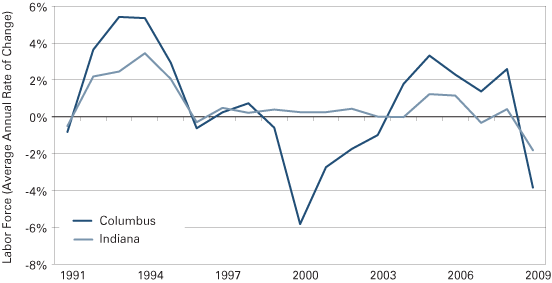Columbus Forecast 2011
Interim Head of the Division of Business and Senior Lecturer in Finance, Indiana University–Purdue University Columbus
The impact of the recession is lingering longer in Columbus than most expected. That should be no surprise since it is lingering longer everywhere than most anyone expected.
Beyond the economic data, trends and policy debates, the economy of 2011 has the feel of something waiting just off to the side. New jobs are scarce and unemployment is high—but both are getting a little better. Business is slow and frustrating—but not actually anemic. Nothing is as muscled as we have come to expect following a recession.
In Columbus, good things are happening. It is just that we all seem to be waiting for more economic fuel and thrust.
Take unemployment, for example. At this time last year, 9.6 percent of the workforce in Bartholomew County was unemployed. Now the rate had dropped to 8.5 percent (as of September, not seasonally adjusted). That is a significant improvement. The Indiana unemployment rate overall stood at 9.5 percent last September, dropped a little and rose back again. A year later, it is still 9.5 percent (see Figure 1).
Figure 1: Monthly Unemployment Rates, January 2005 to September 2010

Source: IBRC, using Bureau of Labor Statistics data
The drop in the unemployment rate is even more interesting given that more than 30 percent of the jobs here are in manufacturing (twice the proportion of Indiana overall). In other areas across the state where manufacturing plays a large role in terms of overall employment, those areas’ unemployment rates are noticeably higher. In fact, both the Anderson and Kokomo metros are less dependent on manufacturing than Columbus, but their unemployment rates are 10.7 percent and 11 percent, respectively.
Unfortunately, one reason for the drop in the unemployment rate is a declining labor force. This most likely signals movement out of the area as individuals lose hope about their job prospects, and it varies more widely for the Columbus area than for the state overall (see Figure 2). Since the Columbus labor force peaked in July 2008, it has now dropped by nearly 10 percent. Bartholomew County has lost an estimated 4,600 jobs between the years 2008 and 2010—a fall of 8.3 percent.
Figure 2: Average Annual Rates of Change in Labor Force, 1991 to 2009

Source: IBRC, using Bureau of Labor Statistics data
While the downward trend in unemployment is welcome, this won’t matter much to individuals and families for whom there is still a lot of job pain. And yet the activity off to the side shows much promise.
- Tourism remains strong for Columbus. A strategic focus on amateur sporting events, such as softball and baseball tournaments, brings thousands of visitors into the area.
- Camp Atterbury continues its physical expansion. Not only is that a direct driver of new jobs, the increase in training means more U.S. service personnel leasing area apartments, shopping at area retailers and eating at area restaurants.
- The housing market is still slow, but record low interest rates and a healthy supply of good homes suggest home sales are ready to pick up quickly as soon as confidence in job prospects does.
- The loss of Irwin Union Bank—last year’s last straw—has turned into a nice example of economic creative destruction. First Financial Bancorp managed a clean acquisition of Irwin’s assets and now is asserting itself as a full-fledged member of the community. Its planned banking center is yet another construction project scheduled for downtown.
- Cummins hums along at a quick pace, tied into a global economy that directly benefits local Hoosiers. Its overall sales growth and profitability is obviously important to the area. It is also creating jobs: 200 in Seymour to the south, and in a dramatic announcement in October, 350 mostly professional jobs when it takes over the former Irwin bank building just across the street from its headquarters. (This is the building First Financial will vacate in favor of its new banking center.)
- Columbus is even taking jobs away from Mexico. Late in the summer, Caltherm Corp. announced that it would transfer equipment from its Mexico facility to an expanded Columbus plant and then bring on 32 more jobs.
The Outlook
With Indiana set to continue its slow recovery in 2011, Columbus and Bartholomew County should as well. Economic growth will climb just ahead of the state average. Personal income is expected to average 4.7 percent growth through 2013, according to the economic model from the Center for Econometric Model Research. Job growth will rise just slightly behind the state overall, though unemployment should continue to decline at a quicker pace than the state.
Despite new job creation in areas outside manufacturing, it will be several years before employment recovers to pre-2008 levels.
The good news is (and has been for a while) that manufacturing in the area benefits from its engagement with the global economy. That diversity has already helped Cummins and other area firms avoid the devastation common elsewhere in manufacturing-heavy communities. It is also likely to continue supporting the existing quality manufacturing jobs.
Also in this Issue…
- Outlook for 2011
- International Outlook for 2011
- U.S. Outlook for 2011
- Financial Outlook for 2011
- Housing Market Outlook for 2011
- Indiana's Outlook for 2011
- Indiana's Agricultural Outlook for 2011
- Anderson Forecast 2011
- Bloomington Forecast 2011
- Columbus Forecast 2011
- Evansville Forecast 2011
- Fort Wayne Forecast 2011
- Gary Forecast 2011
- Indianapolis-Carmel Forecast 2011
- Kokomo Forecast 2011
- Lafayette Forecast 2011
- Louisville Forecast 2011
- Muncie Forecast 2011
- Richmond Forecast 2011
- South Bend and Elkhart Area Forecast 2011
- Terre Haute Forecast 2011




